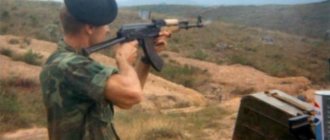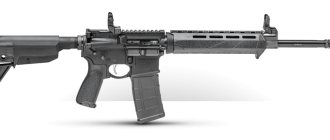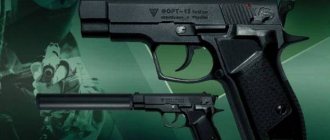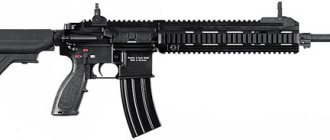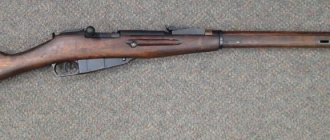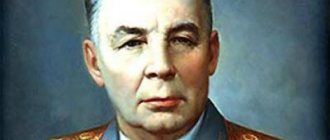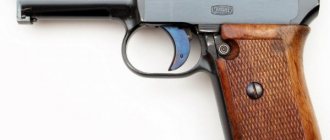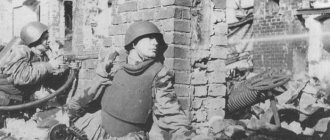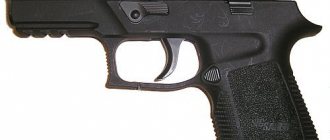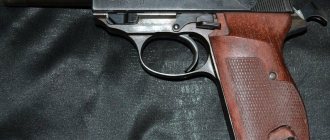Obsolete weapons
America entered the second half of the 20th century with a complex of small arms that had not changed at all since the times of “First in Basatogne”, “Aachen to Essen” and the death of Comrade Fuhrer. The same M1 M3 submachine gun (“oil can”) produced by GM Guide Lamp Division, the M1/M2 (erroneously called “baby Garand”) developed by the criminal and self-taught designer David Williams and machine gun (more like an automatic rifle) BAR M1918A2 from the hands of the great John Moses Browning himself. These were excellent examples of small arms, and their only problem was that they were... a little outdated.
M1 Garand
The M1 Garand, the world's second self-loading rifle, has officially entered service as the primary infantry weapon. The first was the Soviet ABC-36. To the credit of American weapons, I must say that the Garand turned out to be simpler and more reliable than ABC, and two orders of magnitude more of them were produced (about 5.5 million versus 65 thousand ABC-36, the numbers are not comparable)
M3A1
M3A1, or simply “oil can” - because it looks like a “pistol” for injecting (ask your grandfather what he did with his Victory). Features: a virtually sealed receiver, a powerful 11.43 mm .45 ACP cartridge, a purchase price of 15 wartime dollars (a little over 200 today). This is almost cheaper or even cheaper than PPS-43, which itself is breathtakingly cheap and simple. Everything is cheap and simple here too. And angrily
M1 carbine
M1 carbine - in version for paratroopers (top) and infantry (bottom).
In a small store (practically a store) there is a not-so-small cartridge 7.62x33 , aka . 30 Carbine - such an intermediate cartridge “at minimum”
M1918A2 BAR
The epic M1918A2 BAR gun is straight out of 1918 (it's a modification of the 1928, but not much has changed). It was developed to provide fire support to its colleagues in a dangerous business storming German positions. Due to such a narrow specialization, it did not produce a normal light machine gun, but, for lack of anything better, the Yankees went through the entire war with it. By the way, the complex lever-locking bolt design - the work of John Browning - was sold to the Belgians after the war, where it was perfected, and the BAR design itself was taken to its logical limit (FN Model D and DA) and taken as the basis for the creation of the FN MAG . And the enterprising Belgians sold the license for it back to the States, where this work of art received the M240 index. The Belgians proved themselves to be real businessmen from the times of wild capitalism, with European specifics.
Agree, an automatic rifle with a magazine for 20 rounds and weighing 9 kilograms or an infantry self-loading rifle with a burst load of 8 rounds (both chambered for a massive, heavy and painfully hitting the shoulder 7.62x63 Springfield ) look much more faded when “ The Reds are already actively adopting a carbine, an assault rifle and a machine gun chambered for the intermediate cartridge 7.62×39 M43
AK type 3
AK type 3, produced from 1955 to 1960. All the signs are there - the butt is beveled down, a wooden pistol grip with a metal base, a square beveled recess under the cartridge ejection window
SCS
SCS on top. Sergei Simonov knew how to design beautiful weapons, you can’t say anything... Below is a civilian AKM (Vepr-KM).
RPD
Degtyarev light machine gun, also known as RPD. Initially it was designed for a machine gun competition, but then it moved to the machine gun competition, where it beat everyone, to the delight of GRAU employees
Moreover, the machine gun (RPD), with the same 9 kilos of weight, already has a belt feed (100 rounds per belt), the assault rifle (AK) has an impressive magazine for 30 rounds, an automatic fire mode and a range of relatively aimed fire up to 300 meters. Carbine (SKS)... it's just better and doesn't need packs. Perhaps all these weapons are not the most accurate and accurate, but it is better to fire 5 bullets per second and accurately hit the target with at least one, than to fire one and possibly (!) hit. Isn't that right?
Assault rifle (automatic) MP-43 / MP-44 / Stg.44
With the Nazis coming to power in Germany in the 20th century, the rearmament of the Wehrmacht began. The army command, having analyzed the prospects for the development of weapons and equipment, taking into account their tactical use, came to the conclusion that one of the tasks of creating qualitatively new armed forces, ready for large-scale offensive actions, is to equip them with weapons more advanced than those available to potential opponents.
Stg.44
The tactical and technical task (TTZ) for the creation of a new weapon, drawn up by the Wehrmacht Ground Forces Weapons Directorate (HWaA - Heereswaffenamt), began with the requirement to develop a cartridge of reduced power for firing at a distance of up to 1000 meters. As a result, an intermediate “short” cartridge of 7.92x33 mm caliber (7.92 mm Kurz) was developed.
The initial tactical and technical requirements, which determined the main features of the design of weapons chambered for the “intermediate” cartridge, were revised after numerous studies carried out in 1935-1937, and by 1938 the concept of a program of light automatic small arms was developed, designed to replace the submachine gun, repeating rifle and , partially, light machine gun. This would allow the army to have only two (instead of the previous three) small arms systems - an assault rifle and a single machine gun to perform all tasks.
The accumulated experience, which took into account the latest achievements both in scientific thought and in the production of complex precision engineering products, led to the development of fairly rigid and accurate technical specifications established by HWaA for new weapons.
Mkb.
42 (H) On April 18, 1938, the research bureau of the 2nd department for testing and design of technical equipment HWaA entered into a contract with the owner of the Suhl arms company CG Haenel, the famous gunsmith Hugo Schmeisser, for the development of an automatic carbine.
The new carbine received the official name Mkb (Maschinenkarabin - automatic carbine), which differed from the name MP (Maschinenpistole - submachine gun).
The design team for the Mkb design was headed by H. Schmeisser himself. At the beginning of 1940, he handed over to the HWaA the first prototype of an automatic carbine chambered for a “short” cartridge.
From the end of 1940, another one of the most famous German arms companies (Walther) joined the fight for a lucrative order under the leadership of Erich Walter, who managed to obtain a contract for his company from HWaA to conduct research on the Mkb program. He was asked to create a weapon system on the same terms as CG Haenel, but using a fully developed sector magazine from the Mkb Schmeisser system with a double-row arrangement of thirty rounds.
The first prototype was manufactured in a short time, and already at the beginning of 1941 it was presented to the officers of the HWaA artillery and technical supply department. Although the carbine showed satisfactory performance during shooting at the Kummersdorf training ground, work on fine-tuning this still imperfect design continued throughout 1941.
Mkb.
42 (W) At the end of January 1942, to conduct extensive competitive testing, HWaA required CG Haenel to increase the original order for the production of Mkb in 1942 to 200 units, and Walther was required to submit 200 automatic carbines of its design by July 1942. HWaA assigned the name Mkb-42 to both systems, and the CG Haenel product with the index “H” - Mkb. 42 (H), and the Walther machine gun, respectively, “W” - Mkb. 42 (W).
After demonstrating prototypes of Mkb. 42 (W) and Mkb. 42 (H) at the official display in July of the same year, the leadership of the German Ministry of Armaments and HWaA remained firmly confident that both companies would soon finalize their products and by the end of the summer they could be put into production. Moreover, it was assumed that by November the firms would be able to produce 500 Mkb, and by March next year the total production would be able to be increased to 15 thousand monthly.
But these plans were not destined to come true.
In August 1942, after testing the Mkb. 42 (W) and Mkb. 42(H) HWaA has added new requirements to the original specifications. A generalization of the experience of combat operations, both on the Eastern Front and in Africa, showed that a promising model of the infantryman’s main weapon should be multifunctional, that is, it should hit not only with fire, but also (in close combat) with a bayonet and butt. Taking into account the installation of 98k rifle grenade launchers on standard Mauser carbines, it was decided to have similar devices on the Mkb. Firms were instructed to mount a bayonet lug on the barrels of automatic carbines and provide the possibility of mounting a 1940 model over-caliber rifle grenade launcher. The changes did not last long, but slowed down the transfer of Mkb. 42 in production. At the same time, problems that CG Haenel had with subcontractors, and Walther had with setting up press-stamping equipment, led to the fact that by October, not a single Mkb of the Mkb ordered to each company had been manufactured. Mkb.
42 (W) with a grenade launcher mortar. In November, Walther, with a monthly production rate of 500 units, delivered only 25 Mkb. 42 (W), and in December - 91 pieces. Thanks to the support of the Ministry of Armaments, both companies were able to solve the most serious production problems by the beginning of 1943. Thus, of the 500 Mkb planned for production in January of that year, only 200 units were short-delivered, and in February Walther and CGHaenel actually exceeded production levels, producing 1217 carbines instead of the planned thousand units. Minister of Armaments of the “Third Reich” Alfred Speer, in order to more fully study the service and operational characteristics of the Mkb. 42 (H) and Mkb. 42 (W), orders that a number of carbines be sent for military testing to the Eastern Front.
Both automatic carbines, due to the rigidity of the HWaA specifications, as well as the widespread use of stamping and welding in technology, had great design similarities. Tests revealed that although Mkb. 42 (W) and was lighter, more compact and better balanced, which greatly affected the shooting performance, there was still no doubt that its sophisticated automation was not suitable for use in adverse field conditions. Mkb. 42 (N) turned out to be simpler and more reliable than its competitor. Based on the results of tests of the new weapon, HWaA decided to give preference to the Schmeisser design, but only after making some changes to it.
MP-43 incomplete disassembly
The trigger mechanism has undergone major processing. Application of the rear sear in Mkb. 42 (N) provided single and continuous fire, however, the production of single shots, and even with a striker-fired trigger mechanism, raised reasonable doubts about the accuracy of shooting due to the impact of the bolt on the stump of the barrel at the moment of firing. To improve the accuracy of the combat, the original design of the trigger mechanism was replaced with a more reliable Walter trigger system, with the moving parts of the bolt stopping in the forward position.
The design of the sear was changed, instead of the reloading handle inserted into the groove, a safety catch was installed, the piston stroke was changed from long to short, and the gas chamber tube was shortened.
The functioning of the weapon in difficult operating conditions was improved by replacing large cross-section windows for the escape of residual powder gases from the gas chamber tube with holes with a diameter of 7 mm. Technological changes have been made to the bolt and bolt carrier with a gas piston. The guide bushing of the recoil spring was removed. Due to the revision of some views on the tactical use of an automatic carbine, the bayonet tide was removed, which, by the way, was facilitated by the adoption of the Gw.Gr.Ger.42 rifle grenade launcher with a different method of mounting on the barrel. Due to the use of beech wood in the production of the stock, its design was also simplified.
Most of the parts were produced by cold stamping with widespread use of spot welding to join parts. The outer surfaces of the receiver, forend, magazine and other parts of the machine gun were processed with zig machines, which extruded grooves of different profiles, which significantly increased the rigidity of these parts, made of thin sheet metal.
One of the major shortcomings of the new machine gun, which was not eliminated by the designers, remained its large mass (more than five kilograms), which complicated its use in infantry units as the main model of individual small arms.
| MP-43 / MP-44 / Stg.44 |
Thanks to the support of Minister A. Speer, in June 1943, the modernized weapon under the symbol MP-43 (Maschinenpistole-43 - submachine gun model 1943) went into production. The term “submachine gun” was used to designate this weapon for camouflage, so as not to irritate Hitler, who could not get used to the idea that there would be millions of outdated rifle cartridges in German warehouses. And this happened at a time when even staff officers in Berlin recognized the effectiveness of the new weapons and their ammunition. Speer himself began introducing the MP-43 into mass production.
In September, on the Eastern Front, the first full-scale military tests of the MP-43 took place in the elite German unit - the motorized SS division "Wiking". A report on combat use of assault rifles by more than half of the shooters noted that the MP-43 is an effective replacement for submachine guns and rifles. The new weapon significantly increased the firepower of infantry units and reduced the need for them to use light machine guns for fire support. Fire to a depth of 400 meters was carried out with single shots, then during the battles at close approaches the machine gunners switched to firing in short bursts.
| Caliber, mm | 7.92×33 Kurz |
| Length, mm | 940 |
| Barrel length, mm | 419 |
| Weight, kg | 5.22 |
| Store, count. cartridges | 30 |
| Initial bullet speed, m/s | 685 |
| Effective firing range, m | 300 |
| Rate of fire, rds/min | 500 — 600 |
This combination of firepower and the ability to fire two types of fire in the MP-43 made such a strong impression on the SS generals that already in their first reports they asked Hitler to allow immediate mass production of the machine gun. According to front-line soldiers, the MP-43 is a reliable weapon. Its simplicity with incomplete disassembly and assembly was noted. It was also captivating that the weapon provided good indicators of combat accuracy when firing with single fire at a distance of up to 600 meters (at a greater distance, specially trained snipers were already shooting), and when firing in short bursts, effective fire was carried out up to 300 meters. When firing continuously at 100 meters from the MP-43 at a target with a diameter of 11.5 centimeters, more than half of the hits fell within a circle equal to 5.4 centimeters. The new cartridges, being lighter, smaller in size and having less recoil energy, have also proven themselves to be good. When firing from the MP-43, the recoil force was half that of the standard Mauser 98k carbine. With the “short” 7.92 mm cartridge, by reducing the weight of the cartridge, it became possible to increase the ammunition load of each infantryman. Ammunition for 150 rounds of ammunition for the Mauser 98k carbine weighed 3.9 kilograms, and 150 “short” rounds of ammunition for the MP-43 weighed 2.6 kilograms, which made it possible to increase their stock to 180 rounds of ammunition, placed in six magazines, which were carried in two pouches. In total, the total weight of the machine gun with full ammunition did not exceed 10.3 kilograms, which is about one kilogram heavier than the Mauser 98k carbine with a bayonet and ammunition. The excessive heaviness of the machine gun itself, compared to a carbine or submachine gun, was one of the few disadvantages inherent in the MP-43, which was largely compensated by its many advantages. The disadvantages of the machine gun, which caused complaints from front-line soldiers, included the fact that, in addition to the inconvenient sight located on a high stand, when firing at night, a strong flame erupted from the barrel of the weapon, unmasking the shooter.
Urgent appeals from the front-line soldiers, supported by the HWaA and Armaments Minister A. Speer, as well as the test results, ultimately broke Hitler’s stubbornness. After he personally asked the troops for their opinion on the new machine gun and received positive feedback, at the end of September 1943, an order was given to adopt the MP-43 into infantry service and launch its mass production.
| MP-43/1 |
MP-43 with an infrared sight
This decision accelerated further work by the leading designers of CG Haenel. In the fall of 1943, the MP-43/1 appeared, produced in small quantities by Merz-Werke. It differed from the base model by the presence of a new 30-mm Mkb rifle grenade launcher. Gewehrgranatengerat-43 (later known as MP.Gw.Gr.Ger.43), which was threaded onto the muzzle of the barrel, rather than secured with a clamping device like the Gw.Gr.Ger.42 grenade launcher on the MP-43. In this regard, the configuration of the barrel has changed - its outer section has one diameter, unlike the cylindrical-stage one in the MP-43. To protect the threads from damage, an extended barrel sleeve was screwed onto the barrel. The configuration of the butt has also changed, and to reduce recoil, the dimensions of the butt plate have increased.
For snipers, a sample MP-43/1 was created, on which a milled mount was installed for four-fold optical sights ZF-4, as well as infrared night vision sights ZG.1229 “Vampire”. For trial operation, a batch of 300 MP-43/1 with such a sight was manufactured. The Vampire landing mount was mounted on the right side of the receiver.
The Stg.44 could also be equipped with a special Krummlauf Vorsatz J curved-barrel device, designed for firing from tanks (and other shelters) at the enemy in the dead zone near the tank.
| MP-43 / MP-44 / Stg.44 with a curved barrel attachment for shooting from behind cover |
On April 6, 1944, the Supreme Commander-in-Chief of the German Armed Forces issued an order dedicated to the Wehrmacht small arms system, where the name of the MP-43 submachine gun was replaced by MP-44. Apart from a change in the year of production in the index - from 1943 to 1944 - nothing else can explain this replacement, since no innovations were made to the weapon itself.
The complication of the military situation influenced the fact that in October 1944 Hitler had to issue another order, according to which the MP-44 received a new (for the fourth in two years, and this time the last) name - Stg-44 (Sturmgewehr-44 - assault rifle model 1944). This was most likely explained by political and propaganda considerations rather than anything else. The change in designation - “submachine gun” to “assault rifle” - began to more accurately reflect the role and main purpose of this weapon in battle.
| MP-43 / MP-44 / Stg.44 |
stamp Stg-44
No changes were made to the design of the machine gun, with the exception of the stamp Stg.44, which was placed directly on the old stamp MP-44 located on the receiver. In all likelihood, this is typical only for weapons released at the end of 1944. The MP-43/MP-44 assault rifles were used, first of all, by selected troops - motorized units and formations of the Wehrmacht and SS field troops.
The history of the German MP-43 / Stg-44 assault rifles did not end with the surrender of Germany. After the war, from 1948 to 1956 they were in service with the barracks police of the GDR and in 1945-1950 - in the airborne troops of the Yugoslav People's Army.
| Stg.44 in various manufacturing options |
The NATO army is in the process of rearmament. We'll go the other way!
“It’s not like that at all!” - said the big bosses from the Infantry Board, and preferred tactical and technical characteristics to mass production.
The starting point for the rearmament program was the assertion that every American is a born... if not a sniper, then certainly a Marxman. Nobody cared how much this hypothesis correlated with reality, that’s it, period. Every John from Minnesota knows how to hit a large target at a distance of a thousand yards (about 900 meters), and question this axiom... are you a communist? It hits, period. This was proven by some strange experiments, where a barrel was placed on the water, a soldier took aim at the splashes of water from a thousand yards, and after a minute of sighting the accuracy was about 20%. How realistic this situation is in a battle where people fight not only with a rifle is an open question.
Subscribe to our newsletter
Note: Marksman is a sniper in the unit.
The richest and most diverse experience of the Korean War was interpreted in exactly this way - through the prism of one’s controversial (and from the position of after-knowledge, completely false) opinion. The soldiers' reports, in which a Chinese people's volunteer and half a million of his friends walked “through the mountains, across the grass and sand, past the quiet steppe Manchu villages,” were taken at face value - and yet they said that the Chinese were advancing in armored quilted jackets!
Armor carrier in the foreground
The absurdity of such a statement can hardly be doubted, but the reason why intelligent American commanders passed it off as the ultimate truth lies on the surface: in order to pierce a quilted jacket, you must first hit it. And it is advisable to hit it with a rifle, firing a full-fledged rifle cartridge. And the M1 carbine, widely used in the military, was at one time created... not for this. It was given to paratroopers, tank crews, artillerymen, crews of various equipment, special forces, in a word, to those who are now entitled to a modern submachine gun or PDW. At 300-400 meters, the bullets of the 7.62x33 cartridge lost energy, which caused both accuracy and destructive power to drop.
M1 carbine
M1 carbine and Sir Winston Churchill as a frame of reference. Here you can clearly see that the gun is very small. And it shoots small bullets too
M3 carbine
And this is the M3 carbine (M2 with mounts for various sights) with a 30-round magazine, a front handle and, in fact, an M2 IR sight. The sight itself is tubular in shape, the “plate” on top is an infrared spotlight for working in active mode. Approximately the same system as the night channel of the 1K13 tank sight and the L-4A infrared illuminator.
One rifle to rule them all
In other words, USArmy decided to change something. And not even “something”, but everything at once, do “one rifle to rule them all” . European (quite logical) attempts to create a rifle chambered for an intermediate cartridge were nipped in the bud by the States, as a key force in the newly created NATO. The ideas promoted in the Old World were extremely sound, so the Americans’ refusal looked at least strange. The no longer very great Britain was in full swing developing its futuristic EM-1 and EM-2 chambered for the .280 British FN FAL prototypes for the fascist German 7.92x33 Kurz and the British .280, the French were in full swing exploited the German “Varangians” to create a carbine according to the StG45(M) scheme for the American .30 Carbine, the Spaniards received “used” Germans from the French and reworked them for their 7.92x40 CETME cartridge.
EM-1
EM-1 (Korsac) 1946, the brainchild of Roman Korsac, a Polish emigrant.
In 1947, instead of Korsak, a certain Stefan Janson became the head of the development group. It is notable primarily for the fact that of the rifles that I will present below, this is the only one created for a rifle cartridge. The same goes for the German 7.92x57 (the British .303 had a rim, but it seems that only we can design successful automatic weapons chambered for a cartridge with a rim). The mechanics are completely copied from the German “paratrooper rifle” FG-42, the only modification is that everything is turned into a “bullpup” design. After 25 thousand pounds spent on development, the work was canceled under the pretext “why do we need EM-1 when we already have EM-2 on the way?” BSA 28P, Thorpe EM-1, Janson EM-2
BSA 28P - something automatic for .280, made according to the scheme with a movable cylinder locked behind the left wall of the receiver, looks like a Ruger Mini-14, was rejected almost immediately after the start of testing. EM-1 (Thorpe) is not a rival to Korsak’s EM-1, but a separate development, a mechanically overcomplicated copy of the StG 45(M) - a gunsmith’s worst nightmare, because to disassemble you have to stomp on the stock with your feet, inside the bolt you need to remove parts the size of a fingernail, and to remove the mainspring you need a teaspoon! (more precisely, the return spring cannot be removed without a flat-head screwdriver, and the screw head is such that it is just right for an army teaspoon Spoon, Tea, No.I Mk.1 *). The EM-2 (Janson) is a fairly simple mechanically (but complex to manufacture, requiring a lot of precision turning) copy of the German G43. It was put into service in 1951 as Rifle, No.9, Mk.1, but was withdrawn the following year.
Internal structure of EM-1
The internal structure of the EM-1 (Thorpe) is a horror that flies on the wings of the night. I'm scared to think what would have happened if it had been adopted
Janson's EM-2, FN FAL prototype chambered in .280
Above and in the middle is Janson’s EM-2, the same Rifle, No.9, Mk.1. At the top is a carbine for paratroopers and armored vehicle crews, in the middle is a full-fledged infantry rifle. On the carrying handle you can see a conical casing - a single-magnification optical sight (i.e. without magnification) is hidden under it. The British, not unreasonably, believed that through such a sight it would be more convenient to quickly take aim and open fire at the main combat distance - 300 yards and closer, and firing further was not the task of the shooter, but of the machine gunner, grenade launcher, mortar gunner... anyone, but not the shooter. Below is a prototype FN FAL chambered in .280. The difference in the length of the rifles is very clearly visible - and this despite the fact that the FAL has a 21.5-inch long barrel, the “short” EM-2 has about 20 inches, and the “long” one has a 24.5-inch barrel. This is a very, very long barrel, which even with an intermediate cartridge gave excellent ballistics
StG 45(M), CEAM Modele 1950
At the top is the StG 45(M), aka Gerät 06M, aka the “Mauser Sturmgever” under 7.92x33 Kurz. Mechanically, it is a rather simple and elegant weapon with a short stroke of the gas piston and locking with a pair of rollers behind the walls of the receiver. Served as a prototype for the British EM-1 (Thorpe) rifle, which I have already said a word about, and for the French CEAM Modele 1950 carbine (chambered .30 Carbine), which is in this picture below. In both cases, it could not have happened without Ludwig Forgrimmler
AME-1
And this is Vorgrimmler Modell 1, also known as AME-1, a French development from 1948. The designer is the German “Varangian”, Ludwig Vorgrimmer, who during the war years developed the StG 45(M) from the previous picture. AME-1 competed with the automaton of Theodor Loeffler's scheme and lost to him, after which Forgrimmler switched to helping Loeffler (and then got completely tired of the French management style around him and went to work in Spain at CETME). From this union the CEAM Mod.50 was born, which was also in the previous picture. This is such beauty. What is especially interesting for us is that in it Herr Forgrimmler (apparently) for the first time used his, which soon became a family feature of his weapon, scheme with a semi-free shutter, slowed down by the very pair of rollers with which his earlier designs locked the shutter. Without a doubt, a talented designer
CETME Model A prototype
One of the CETME Model A prototypes that fell into American hands and was tested at the Aberdeen Proving Ground. It is especially notable for the fact that it is chambered for the 7.92x40 CETME cartridge (that’s why the magazines are so crooked—tapered, sir...). Again, it’s the work of Forgrimmler, so it’s a semi-free shutter with roller recoil braking. The tube above the barrel is not a gas tube, as you might think. There is a tubular protrusion of the bolt frame (made to make it heavier and slow down the recoil), with which the cocking handle is connected
Serial CETME
Serial CETME - but already under the NATO cartridge. Model B - early production, Model C - late production, Model L - carbine for all kinds of paratroopers
CETME 58 Model C, Mauser-CETME
Fun prototypes of Dr. Forgrimmler and his team. On top is the CETME 58 Model C, chambered for the domestic 7.62x39 M43 cartridge. It was offered to Finland when the ardent Ingrians opened a competition for a new rifle in the late 1950s. As a result, the Finns chose the Valmet Rk 62 - a modification of the Polish AKM from the design bureau of the Valmet plant - and they knew no grief with it. Below is an experienced Mauser-CETME machine gun chambered for NATO. It was not accepted into service either in Germany or in Spain.
Stg.45 and other assault rifles by Ludwig Forgrimler
Many articles about the first mass-produced German assault rifle Stg.44 mention that designer Ludwig Forgrimler, representing the weapons company Mauser Werke, participated in the competition for the new weapon.
The project, which was led by the designer, was called “Device 06” (Gerät 06) and had a number of really interesting ideas and solutions that other designers came to only several decades later. History of weapons by Ludwig Forgrimler
Mauser Werke entered the competition for a new weapon chambered for the intermediate cartridge in 1939 and remained slightly behind Haenel and Walther throughout the competition. This was explained by the fact that the weapons developed by the company’s designers had a lot of truly revolutionary ideas, the implementation of which could lead to the creation of reliable and cheap weapons for the mass armament of the army.
The development process was also slowed down by such things as the replacement of the automation system actually in the middle of work on the weapon and the search for new technological processes in production. The designers of the Mauser Werke company may have taken the development process too seriously, but it yielded certain results at the very end of World War II.
In 1943, the new machine gun passed factory tests, showing a result of 6 thousand shots without delay. In 1944, the Wehrmacht Armament Directorate received 4 weapons for field testing; at that time the machine gun was designated Mkb.43. By the end of 1944, a decision was made to accept the new weapon into service and begin production under the designation Stg.45.
For obvious reasons, mass production of the machine gun from the Mauser Werke company was never established, which was for the better. It is unlikely that a soldier’s personal weapon could have changed the outcome of the war, but it could have made the last battles more intense. If we compare the Stg.45 with the Stg.44, with the same combat characteristics, the Forgrimler assault rifle had less weight and easier maintenance. The weapon cost a little less than half as much to produce and required half the man-hours. There can be only one conclusion to this - the weapon for its time, if it was not ideal for fully arming the army, then strived for the ideal.
With the surrender of Germany, Ludwig Forgrimler moved to France, and then to Spain. It was in Spain that the designer managed to establish mass production of his weapons, but for a different ammunition. In 1949, Ludwig Forgrimler received a position at the Center for Technical Research of Special Materials. It was in this institution that small arms were developed for the Spanish army.
Initially, the designer began to adapt his weapon for the 7.92x40 cartridge, but due to the fact that the United States was pushing its 7.62x51 ammunition, this work was curtailed in favor of weapons for the future NATO standard cartridge.
In fact, the designer’s further developments can be considered light machine guns, according to the domestic classification, since the cartridge used was not an intermediate cartridge, but a rifle cartridge. But according to the Western classification, all weapons subsequently developed by Ludwig Forgrimler were classified as assault rifles.
The first result of the designer's work, in the form of a mass-produced weapon adopted for service, was the CETME mod assault rifle. A. This weapon could not use full-fledged 7.62x51 cartridges and was fed with cartridges with similar metric characteristics, but with a lighter bullet and a lower powder load.
A year after the assault rifle was adopted, attention was paid to it, and the German government acquired the rights to produce this weapon. These rights went to the company Heckler und Koch, which had not yet declared itself at that time. This is precisely what can be considered the beginning of the success of the German arms company, since the most successful works, which can be considered a German branch of arms development, are based on the development of Ludwig Forgrimler. Among the weapons based on the developments of Ludwig Forgrimler you can find the G3, HK22, HK21 and, of course, the MP-5.
The Spanish version of the weapon also developed. In 1958, the CETME mod assault rifle was adopted by the army. B. The main difference from the previous model of the weapon was the presence of a forend; in model A, its role was played by a folded bipod, as well as the ability to use full-fledged 7.62x51 cartridges.
The next round of weapons development came in 1964 and again did not bring significant changes. In Model C, changes affected the forend and pistol grip, a diopter sight was installed, and it became possible to remove the folding bipod. To facilitate the extraction of spent cartridges, Revelli grooves appeared in the chamber. This version of the assault rifle was in service with the Spanish army until the mid-80s, exactly until the army began switching to the 5.56x45 cartridge. After being removed from service, a huge number of rifles were sold around the world on the civilian market and beyond.
They replaced the Model C with the Model L only due to the transition to new ammunition. And to be honest, there were no significant changes in the design of the weapon, except for those related to the transition to the 5.56x45 cartridge and a few cosmetic ones.
If you look at the development of the Stg.45 precisely under the leadership of Ludwig Forgrimler, then for half a century the design of the weapon did not change, but was only adapted to new ammunition. This fact indicates a well-chosen scheme of operation of the weapon. But we must not forget that even the most ideal design may turn out to be unreliable and not adapted to unfavorable conditions if the quality of individual parts is low and not the most thoughtful changes are made to the design of the weapon.
Design features of the Stg.45 assault rifle
The main feature of the Stg.45 assault rifle is the design of its automation, and it was the weapon’s automation that remained virtually unchanged in subsequent developments by both Ludwig Forgrimler and in the developments of other designers.
Initially, the German designer developed his machine gun based on automation with the removal of part of the powder gases from the barrel bore and locking the barrel bore using two rollers. However, during the development process, the operation scheme of the machine gun was significantly simplified, replacing the automation based on a semi-blowback. The braking of the bolt group at the moment of firing was carried out using the same two rollers, which did not allow the bolt of the machine gun to roll back in the very first fractions of a second after the shot.
A significant breakthrough was the use of stamped parts and the use of spot welding. This feature and a minimum of parts reduced the cost and simplified the production of the machine gun, which is the main requirement for weapons intended for arming the army.
Characteristics of the Stg.45 assault rifle
Thanks to the stamped receiver and the design of the machine gun, its weight was 3.7 kilograms, which is quite acceptable weight even for modern “plastic” models. The length of the weapon's barrel was 400 millimeters, and the total length of the weapon was 900 millimeters. It is worth making a reservation that the overall length could subsequently be reduced, since the design of the Stg.45 made it possible to install a folding stock and shorten the barrel without major changes. This would be relevant for paratroopers and armored vehicle crews. The rate of automatic fire was 450 rounds per minute. The machine was fed from magazines with a capacity of 30 or 10 rounds.
Pros and cons of weapons
There is no particular point in discussing the positive and negative qualities of the Stg.45 assault rifle as a military weapon, since all information comes down to successful testing of the weapon and its adoption into service. To talk about weapons based on the developments of Ludwig Forgrimler, and especially other gunsmiths, will, at a minimum, be incorrect.
But, despite this, there are a number of facts that even the most skeptical person cannot dispute. Were the weapons developed by Ludwig Forgrimler more technologically advanced than other weapons of the time? Yes. Was it cheap to produce? Yes. Has it become a platform for new developments? Yes.
Despite all this, only a few know the name of the designer, without whom the well-known MP-5 and G-3 might not have existed.
The NATO army must arm itself with an American cartridge. Dot
All this grace, verified by theoretical calculations and the combat experience of German grenadiers and their “Stormgewehrs,” was simply shelved by the Americans, and in return they offered... their old cartridge, with which they went through the First and Second World Wars. Almost.
By the early 1950s, the 7.62x51 (aka .308 and 7.62 NATO) was developed, for which a new rifle was supposed to be created. In fact, it was an old 7.62x63 Springfield cartridge, half an inch (1 inch - 2.54 cm) was sawed off from the cartridge case, maintaining ballistics similar to the Springfield due to the new powders. But it had to be preserved, otherwise the American generals, who demanded that the helmet be penetrated at 1000 yards, would remain dissatisfied.
Subscribe to our newsletter
Despite the smaller cartridge case, the recoil impulse remained almost as strong and was certainly superior to intermediate cartridges. A heavy 150-grain (9.5 gram) bullet with a total cartridge weight of 400 grains (25.5 grams) instantly killed all hopes for more ammunition with the same weight. Just for comparison - 100 .308 rounds weighed 3.5 kg (I counted them already packed into 5 magazines), the same weight could take 120 M43 rounds for AK (4 magazines) when using steel magazines or 150 rounds (5 magazines) when using light alloy magazines. And about 15 more rounds in bulk, so that it would be exactly 3.5 kg, yes.
Here's a comparison for you, please. 7.62x39 M43 and 7.62x51 are available, the .30 Carbine cartridge is slightly longer and narrower than 38 Special, the size of the .280 British can be judged by mentally sticking a 7.62x39 bullet into a .223 cartridge case
All the wonderful ideas of enlightened Europe about creating light carbines for one all-NATO intermediate cartridge, with reduced recoil and other benefits, were buried by the Americans, declaring that the cartridge for the new weapon would be American or not at all. To the words “you promised!” answers were received that can be characterized as follows: “we are the masters of our word - we gave it ourselves, we will take it ourselves” and “did we say that? you dreamed!”
Contest
Three rifles chambered for the new cartridge were submitted to the American competition - T44 from Springfield Armory, AR-10 from Fairchild-Armalite and T48/FAL from FN Herstal (formally from Harrington & Richardson), and with one glance at them one could understand which won, which would have taken an honorable second “almost first” place, and which would have gone to the dustbin of history... if the struggle had taken place on equal terms, with fair competition and a bureaucratic nightmare. But it didn’t happen like that, otherwise I wouldn’t be describing this story here and signing the note with a pretentious title.
The AR-10 was the obvious leader of the competition - lightweight, aluminum-bakelite, with an original and lightweight automation system based on direct injection of spent powder gases into the chamber, without pistons and pushers - the signature feature of its designer Eugene Stoner. It was precisely its openwork lightness that ruined its prospects for entering service - contrary to Stoner’s warnings, the testers arbitrarily installed a composite steel-aluminum barrel on the rifle instead of the usual steel one, and during the “torture test” in Springfield it exploded after a relatively small shot, almost tearing off the tester's hand. The barrel was promptly replaced with an all-steel one, but a reason was given, and Stoner’s brainchild was removed from testing.
AR-10 with "Hollywood Can"
Beautiful AR-10 with a “Hollywood can” (a huge DTK, which was later hung on those versions of rifles that served as props in film studios) and a “waffle” magazine
Dutch Army AR-10
AR-10 of the Dutch army, “waffle” and a fashionable bayonet-knife included
AR-10 of the Portuguese army from the time of Salazar. These beauties suppressed uprisings in Mozambique, Guinea, Angola and even on the Cape Verde Islands
M110 SASS
The M110 SASS (I don't like modern rifles, but this one is awesome) is a modern, creative reimagining of the AR-10 concept. It was first used in Afghanistan, and there it amazed everyone with its accuracy at the bolt-action level, with other characteristics of the DMR
The FN T48 was a licensed Belgian FN FAL rifle and in general was a very advanced system, initially developed for intermediate cartridges, but hastily converted to the American 7.62 NATO. Yes, now it’s definitely NATO - in 1954 the cartridge was finally adopted as the standard of the entire North Atlantic Alliance. The rifle was extremely well thought out, its main parts were made reliable and long-lived, while its designer Dieudonne Seve did not slip into Kalashnikovism and did not sacrifice accuracy and accuracy in favor of reliability.
The rifle was on par with other competitors, losing only in tests in arctic conditions (and even then there is a suspicion that the problem was in the gas regulator, and developing a new one is a matter of two days, one engineer and his trusty slide rule). However, she lost the competition - after all, how is it possible for GIs to get a rifle that was NOT developed IN AMERICA? It didn’t even bother me that the Belgians gave away the drawings for the FAL absolutely free of charge and without any royalties, as a “thank you” for the liberation.
FN T48
FN T48 in person, from the collection of the National Firearms Museum. A protrusion is visible above the window for ejecting cartridges - this is a guide for a clip of cartridges
FN T48E1 HBAR
FN T48E1 HBAR, light light machine gun for squad. The barrel is longer, thicker, a bipod is on it - and you're done! Its Canadian brothers C2A1 were also issued with 30-round magazines, for beauty
T48
An American soldier with a T48 at the USMC Quantico base.
Classic FALs
And these are classic FALs - both German, G1. Yes, the Germans almost adopted it: they tested it, bought an experimental batch, and even issued an index. But the vindictive Belgians refused to sell the license. The Germans had to go their own way...
And finally M14 . An attempt to creatively rework the experience of the Garand and T20 (Garanda loaded with 20-round magazines from BAR), which... well, it worked out. The same bolt with two protrusions, the same gas piston (only now it is short-stroke and has two parts), the bolt is rotated by a moving bar to the right of the aiming line, even the ring sight is the same. But now with automatic fire and 20-round magazines. And of course, nothing good came of it
Atomic Age rifle
Yes, yes, I’m an atomic age rifle, but instead of a pistol grip and fore-end I have a stock, and I’m not ashamed
T25
T25, which did not even pass normal tests
T47
The not very successful T25, which received the T47 index, was brought to mind
M14 EBR
But this is what they make from M14 now. M14 EBR - Enhanced Battle Rifle. In such a role, oddly enough, she turned out to be very good!
NATO Army in search of a universal automatic rifle
The generals’ calculation that the M14 could be produced using equipment for the production of “garands”... did not come true. The rifle was the same, but different. Due to the automatic fire mode introduced into the design and the lightweight design made in some places, the percentage of factory defects has skyrocketed.
The only quality rifles were those produced at the factories of the former electromechanical company TRW Inc., since it invested in an entirely new production line (and failed big time). The recoil due to auto-fire from a powerful rifle cartridge weighing 4 kilograms (this is not a 9-kilogram BAR) was such that when firing in bursts at a tall target from a standing position, about a hundred meters away, the first bullet hit the target, the second went either to its very upper edge, or even passed a little higher, the third flew somewhere... there, and the fourth - already at the supposed location of the artificial Earth satellite launched by them angry Ruskies.
